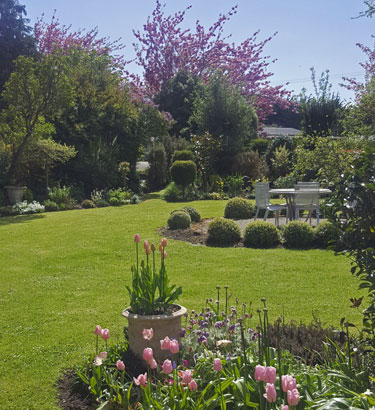Create "Greener Pastures"
Spring on its own is a tonic for lawns. Rising temperatures and spring rains encourage lush green growth. But there is more to lasting good looks than keeping up with mowing. Engaging in a few timely tricks will make it easier to keep your lawn looking good for longer.
Feed
Every time we mow we are removing nutrients. It is important
to replace those nutrients especially during strong spring growth. A well- fed lawn not only looks more lush and green, the strong growth will outcompete weeds. Nitrogen is what a lawn needs most for that lush green growth, but a good lawn food contains the correct proportions of nitrogen and other essential nutrients such as phosphorus for healthy root growth and potassium for disease resistance. Choose a controlled release fertiliser and apply small amounts at regular intervals to avoid wastage and leaching. For a new lawn, choose a product suitable for young grass and apply it at the recommended rate.
Ban weeds and prickles
Broadleaf weeds (non-grasses) are unsightly interruptions in a smooth green carpet. Remove them before they get too big. Special ‘grubber’ hand tools make it easy. For an easier remedy, especially if you have a lot of weeds, ask at your garden centre for a selective herbicide, which kills the weeds without harming the grass. If you have prickles in your lawn, the time to act is in spring before the Onehunga weed sets its seed and while lawns are actively growing. Yates Prickle Weedkiller controls Onehunga weed without killing the lawn.
Aerate
Reducing compaction makes a huge difference to lawns, especially in high use areas. Aerating the lawn allows more air and water to get to the roots. This is ideally done every spring when the soil is moist but not soaking wet. Using a garden fork to punch holes or walking over your lawn with a pair of lawn aerator sandals can make a difference. For very compact lawns, however, core aeration is the best way to relieve compaction. This process uses an ‘aerator’ machine to completely remove small plugs of grass and soil. Core aerators are available from hire centres.
Over-sow
To repair bare patches it is important to prepare the ground first so that the seed can make good contact with the soil. Mow the lawn short and then use a hard steel rake to remove thatch and create shallow grooves in the soil ready for sowing. For extra assurance, sprinkle over some weed- free compost. Then scatter the seed and water gently using a watering can. Water as necessary to keep the seed bed moist. Hollows and sunken areas that have a good cover of turf may be remedied without sowing any seed: Cut and peel back a section of turf and fill underneath with topsoil or lawn mix. Carefully replace the turf and water thoroughly.
Mowing tips
- For a thick, weed free lawn, frequent light mowing is best.
- Mower blades should remain raised when the weather is hot and dry.
- Don’t mow when the lawn is frosty or wet.

1-Sep-2018


